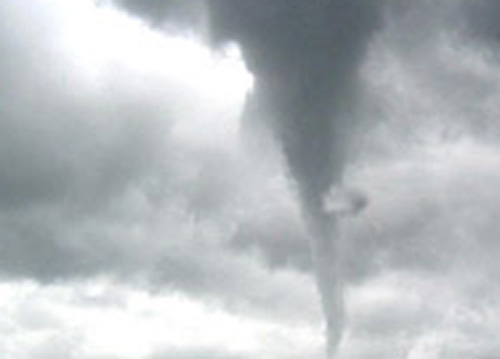
“When
it crossed the Iowa River its color changed instantly to white,” reported an
eyewitness to an
1859 tornado that killed five people along what is not the southern edge of
Iowa City.
This file image is of a tornado cloud a century later.
|
By
Bob Hibbs
A
tornado passed along what is now the southern edge of Iowa City killing five
people, injuring others, and inflicting destruction on several farm homes, an
orchard and crops on an early Sunday evening in late spring 1859.
Among
those killed was Jesse Berry, “a well known citizen,” according to a 1912
description written by C. Ray Aurner. A falling timber struck Berry as his
barn collapsed.
Although
sources leave virtually no biographic material for either man, this may be the
same Jesse Berry who is credited with opening the first local school. That
occurred in 1840 in an 18-by-26-foot oak frame structure built along College
Street just west of Clinton Street when College passed through what now is the
Old Capitol Mall site downtown.
The
Berry building later was moved to the longtime Bartley Law Office site at 528
S. Clinton. It apparently survived a century before being demolished to make
way for the present brick-front structure there.
The
late local historian Irving Weber wrote that a large oak timber from the Berry
building was used as a fireplace mantle in the Bartley home along Ridge Road.
Connection
between the school founder and the man who died in the tornado is not made by
any of the primary writers of local history. Other records show the death of a
person by that name at age 22 in 1909, clearly someone of a later generation.
In
a firsthand account left in Old Settlers’ Association records, John Springer
wrote in 1924 that as a nine-year-old, he watched the 1859 tornado.
“When
it crossed the Iowa River,” Springer wrote, “its color instantly changed
to white, and at a distance of about a mile, it seemed to be 20 feet or so in
diameter, going east at frightful speed accompanied by a dreadful roaring.”
He
said the storm left the Berry farmhouse as only a floor on a foundation,
“not even a board was left of the structure.”
An
1883 Johnson County history reports an eyewitness account that as the 1859
storm crossed the river “it scooped out the water till the bed of the stream
could be seen entirely across.” Curiously, that history records no
fatalities from the storm.
Early
20th century historian Aurner wrote that near the Berry home three
deaths occurred when Andrew Morgan, his son and grandson were killed as the
farmstead was demolished. Other family members were injured.
He
also writes that not far away a hired hand whose name is recorded only as Mr.
McCoy, “had a stake driven in just back of the shoulder from which wound he
died the next morning.”
The
May 24 storm approached from the southwest on what was described as an
ordinary day until toward evening when dark clouds appeared in the west and
southwest which appeared to be an approaching thunderstorm. However, three
lighting bolts in rapid succession seemed to announce something unusual.
“About
this time a black cloud was pointed out, jagged and broken, from which
suspended like an inverted cone or funnel, a smaller cloud,” a witness
reported. “Not many minutes later it became pointed and made contact with
the earth.”
“The
noise from this cloud resembled that of heavy wagons on a plank road, a
rumbling and continuous roar, distinctly heard by all listeners,” Aurner
reports.
Springer
also leaves the story that a farm hand was scooped up by the tornado and
deposited nearly a mile away, practically uninjured. The man declared he was
returning to the east, that he “wasn’t staying in a country where people
were carried to heaven in a chariot of wind.”
Ironically,
Springer wrote, word came later that the man had been killed in a train
accident in the east.
Next
Saturday: The swimming hole at
Woodlawn and other old tales.
Bob
Hibbs collects local postcards and other historic ephemera and researches
history related to them. |